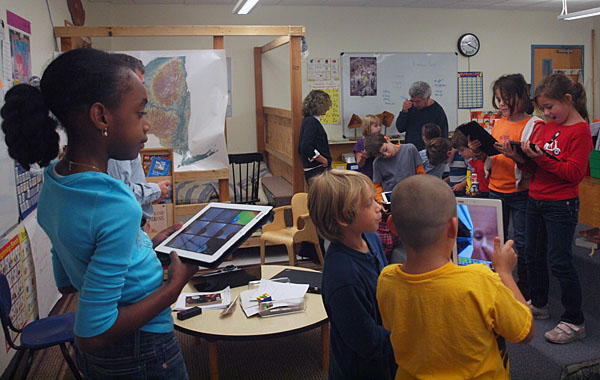 Google and Apple both made big education technology announcements in March, unveiling new products designed for schools. That means two new options for administrators to consider in selecting the best devices for their students. Google’s first Chrome-powered tablet will create new competition for Apple, just as the company announced a new iPad, complete with augmented reality capability, the Apple pencil and a 10-hour battery.
Google and Apple both made big education technology announcements in March, unveiling new products designed for schools. That means two new options for administrators to consider in selecting the best devices for their students. Google’s first Chrome-powered tablet will create new competition for Apple, just as the company announced a new iPad, complete with augmented reality capability, the Apple pencil and a 10-hour battery.
Both tablets will retail for $329. But a Hechinger Report investigation found the price districts pay for ed tech hardware and software can vary widely, with Apple devices in particular. One district got almost $1 million knocked off a large order, even though the company has a reputation for not negotiating at all, beyond offering its education discount from retail prices.
The ed tech purchasing process can be fraught with frustration, particularly if districts know they’re not getting the best deal. But price isn’t the only thing tech directors consider when choosing a device.
Jeff Mao, who led the Maine Learning Technology Initiative for a decade, negotiating a statewide contract to get tech devices to every student in the state, said “total cost of ownership” was at the core of his purchasing decisions.
When school districts buy laptops for students to use in the classroom, the cost doesn’t stop at the price per device. There’s the cost of the warranty, professional development for teachers to learn how to incorporate the devices into their lesson plans and troubleshoot tech problems, repairs for inevitable damages and the price of software those laptops run.
Mao said focusing only on the cost of an individual laptop is like buying a car without factoring in the cost for insurance and gas.
The Consortium for School Networking has a free total cost of ownership tool that helps schools determine the lifetime costs of buying and maintaining networks, computers and devices. But sometimes it’s hard to look beyond the low price tag of a new laptop or tablet, and schools are getting caught making deals that may not be in their best interests long-term.
Apple won Maine’s contracts the entire time Mao led the process. And while Apple is known for having pricier devices, Mao argues he got more for his money than he could with any other vendor because of all that came with those devices.
While other vendors could heavily discount their laptops or tablets, Mao said they had to bring in other companies for the warranties, professional development and software. Apple, which produces its own machines and software and has a robust professional development arm, could offer a lower total price, even if its laptops were more expensive.
“When you just fixate on the commodity purchasing, you can say Dell got me the cheapest box,” Mao said. “But then you have to go buy all the other stuff.”
Keith Madsen, director of technology in East Allen County Schools in Indiana, found the longevity of his district’s iPads to be unbeatable. But Madsen has seen a marked improvement in the functionality and durability of Chromebooks in the last few years, which could change his mind about the best device for his district’s next purchase.
Chromebooks have become the dominant device in U.S. public schools. The market research firm Futuresource Consulting calculated that in 2016, Chromebooks made up 60 percent of all computing devices shipped to K-12 schools. Their low price is widely considered one of their best selling points.
But Gary Lagoy, the technology manager at Camp Verde Unified School District in rural Arizona, prefers a PC over either Chromebooks or iPads because the latter two run on proprietary software. He doesn’t like forcing students to do everything online through the Chrome browser on a Chromebook or being limited to Apple’s software on an iPad.
“You’re locked into something that you don’t want to be locked into,” Lagoy said.
His district stocks PCs, primarily — both laptops and desktops — and it also has some Macs and iPads for students in the younger grades.
Many districts around the country have a mix of devices. They end up making decisions about which products are best for a range of reasons and, classroom needs are a top consideration. As in Camp Verde Unified, many districts have iPads for use in elementary schools, before kids are expected to master a mouse and keyboard, and they transition older students into using laptops. They choose vendors that offer good deals, but they push for functionality that facilitates teaching and learning.
“You’re not buying the device,” Madsen said, “you’re buying for what you need in your district, and you find the device for what you need.”
This story was produced by The Hechinger Report, a nonprofit, independent news organization focused on inequality and innovation in education. Sign up for our newsletter.
